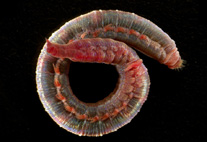Abstract
Colonial animals are often lacking in taxonomic characters due to their small size and the simple morphology of zooids. Since zooid size is nearly uniform in many colonial ascidians, the stigma numbers in each row can be a useful taxonomic character. To evaluate their potential utility, we investigated intraspecific variations in stigma patterns in a subset of photosymbiotic didemnid ascidians, including five morphotypes of Didemnum molle, Lissoclinum midui, Trididemnum clinides, and T. nubilum. Stigma number patterns were almost stable in L. midui and T. nubilum. In contrast, there was considerable variation in stigma number even among clone zooids within the same colony in D. molle and T. clinides. Further, the stigma patterns did not differentiate the five morphotypes of D. molle. There was no significant correlation between the total number of stigma and the length of the thorax in any of the species examined here, suggesting that stigma number is probably invariable within each zooid. Stigma patterns can be usable as a taxonomic character in didemnid ascidians, particularly in species having one or a few patterns. Even in species with various patterns, the range of variation will be informative once such ranges are comprehensively described for didemnid species.
References
Hirose, E. Didemnid ascidians harboring cyanobacteria from Kumejima Island and Tonakijima Island, Ryukyu Archipelago, Japan. The Biological Magazine Okinawa, in press.
Hirose, E. & Oka, A. (2008) A new species of photosymbiotic ascidian from the Ryukyu Archipelago, Japan, with remarks on the stability of stigma number in photosymbiotic Diplosoma species. Zoological Science, 25, 1261–1267. http://dx.doi.org/10.2108/zsj.25.1261
Hirose, M. & Hirose, E. (2009) DNA-barcoding in photosymbiotic species of the genus Diplosoma (Ascidiacea: Didemnidae) and a description of a new species from the southern Ryukyus, Japan. Zoological Science, 26, 564–568. http://dx.doi.org/10.2108/zsj.26.564
Hirose, E. & Nozawa, Y. (2010) Photosymbiotic Ascidians from Kenting and Lyudao in Taiwan. Zoological Studies, 49, 681–687.
Hirose, E. & Hirose, M. (2011) A new didemnid ascidian Lissoclinum midui sp. nov. from Kumejima Island (Okinawa, Japan), with remarks on the absence of a common cloacal system and the presence of an unknown organ. Zoological Science, 28, 462–468. http://dx.doi.org/10.2108/zsj.28.462
Hirose, E. & Su, S.-W. (2011) A new record of a photosymbiotic ascidian from Kenting, Taiwan with key to the photosymbiotic species of the genus Diplosoma recorded in the western Pacific. Collection and Research, 24, 83–86.
Hirose, E., Oka, A. & Hirose, M. (2009a) Two new species of photosymbiotic ascidians of the genus Diplosoma from the Ryukyu Archipelago with partial sequences of the COI gene. Zoological Science, 26, 362–368. http://dx.doi.org/10.2108/zsj.26.362
Hirose, M., Yokobori, S. & Hirose, E. (2009b) Potential speciation of morphotypes in the photosymbiotic ascidian Didemnum molle in the Ryukyu Archipelago, Japan. Coral Reefs, 28, 119–126. http://dx.doi.org/10.1007/s00338-008-0425-0
Hirose, M., Nozawa, Y. & Hirose, E. (2010a) Genetic isolation among morphotypes in the photosymbiotic didemnid Didemnum molle (Ascidiacea, Tunicata) from the Ryukyus and Taiwan. Zoological Science, 27, 959–964. http://dx.doi.org/10.2108/zsj.27.959
Hirose, M., Tochikubo, T. & Hirose, E. (2010b) Taxonomic significance of tunic spicules in photosymbiotic ascidians: a quantitative and molecular evaluation. Journal of the Marine Biological Association of the United Kingdom, 90, 1065–1071. http://dx.doi.org/10.1017/S0025315409991263
Kott, P. (2001) The Australian Ascidiacea, part 4, Aplousobranchia (3), Didemnidae. Memoirs of the Queensland Museum, 47, 1–408.
Lewin, R. A. & Cheng, L. (1989) Prochloron, a microbial enigma. Chapman & Hall, Inc., New York, 129 pp. http://dx.doi.org/10.1007/978-1-4613-0853-9
Monniot, C., Monniot, F. & Laboute, P. (1991) Coral Reef Ascidians of New Caledonia. ORSTOM, Paris, 247 pp.
Turon, X. (1986) Morfología de las espículas en las especies de la familia Didemnidae (Ascidiacea) del litral de Cataluña e Islas Baleares. Miscelánea Zoológica, 10, 213–222.

